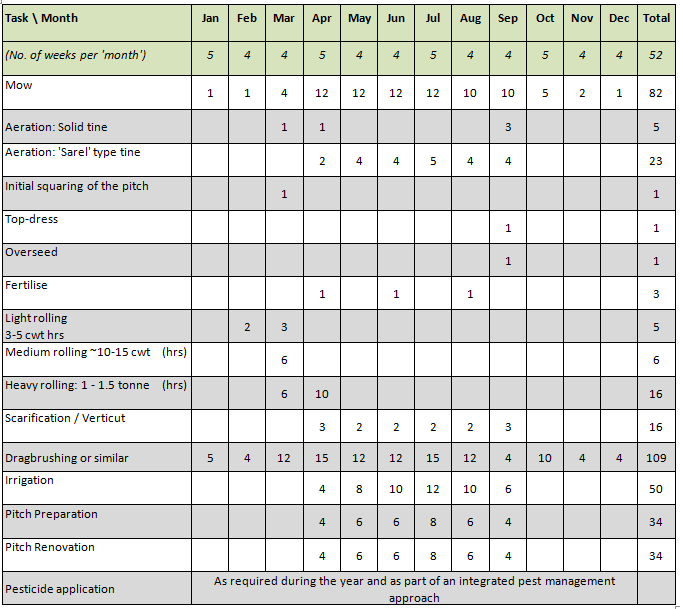The estimated number of occasions for which each task is planned to be carried out can be presented in the form of a maintenance calendar.
The total number of actual operations will vary according to the prevailing weather conditions, as well as the geographic location of the cricket square; each factor can influence the length of the growing season and grass vigour.
Maintenance calendars can provide a very useful means for forward planning and the information can be converted into a staff profile, indicating workload levels, material requirements or budget flow.
The 'Months' in the Table are given as 4 or 5 week periods for convenience; this still adds up to 13 weeks per quarter. There is no reason why, for example, the January month is given as 5 weeks, so long as each quarterly block is made up of one 5 week period and the other two are 4 week periods, thus giving 13 weeks for each quarter.
It is useful to have April as a 5 week period as it gives some more leeway in planning, although this is probably arbitrary.
Each month could also be the exact number of days in a calendar month. Whichever system works for the user, then this is the one which should be adopted.
Table shows 'typical' work undertaken on a cricket square, although the actual work will depend upon the standard of cricket being catered for and the available budget.

Download a word version so you can edit it to suit your own requirements
Rolling of the square has been given as the general number of hours that might typically be spent during the pre-season period, however, this can vary significantly and it is not usually a good idea to state such figures because each cricket square will vary in its requirements: between 20 and 40 hours may be considered an appropriate range for most situations.
The application of pesticides can vary depending upon the content of grasses present, as well as the quality of the maintenance practices carried out.
The amount of pitch preparation and pitch renovation will depend upon the number of games being programmed. For this exercise let us assume that the playing season is 21 weeks (3rd week in April to 2nd week in September) in length and there are an expected 2 games per week. the actual number will vary slightly, but as a planning exercise this will be a good start.
Operations such as switching, systemic fungicide application, moss application, the erection and dismantling of perimeter fencing may also be included within the maintenance calendar.
Some operations, such as scarification may not be carried out over the whole square during the playing season with it being restricted to when each pitch is being prepared.
Verticutting might not be undertaken at all, whilst verti-grooming might be replaced by grooming with a comb attachment fitted behind the roller of a cylinder mower - it depends upon machinery resources.
Some groundstaff do not undertake slit tining during the autumn months, whilst others undertake it on several occasions - a lot of this is personal preference and adapting to local conditions.
